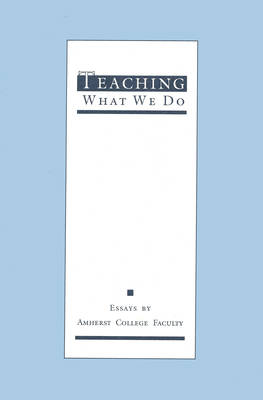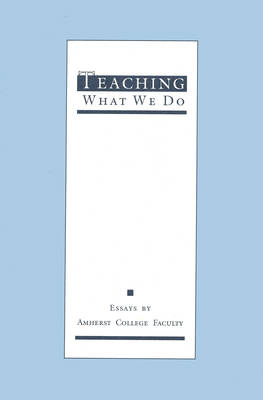
- Retrait gratuit dans votre magasin Club
- 7.000.000 titres dans notre catalogue
- Payer en toute sécurité
- Toujours un magasin près de chez vous
- Retrait gratuit dans votre magasin Club
- 7.000.0000 titres dans notre catalogue
- Payer en toute sécurité
- Toujours un magasin près de chez vous
Teaching What We Do
Essays by Amherst College Faculty
Richard Todd, Douglas C. Wilson
Livre relié | Anglais
33,45 €
+ 66 points
Description
What goes on in a college classroom? For all that has been written in recent years about higher education very little attention has been paid to the heart of the matter: teaching. This book, by members of the Amherst College faculty, helps to repair that oversight. Amherst, in defining itself, places a large emphasis, as it should, on the life of the classroom. No faculty member, no matter how senior, is excused from teaching; no cadre of graduate students shoulders the load of introductory courses. To teach is the central mission of an Amherst professor. But seldom the only mission. Almost everyone who teaches at Amherst also pursues research. Maintaining the balance is sometimes frustrating--but more often nourishing and exhilarating. In his foreword, Peter R. Pouncey speaks of the way in which teaching and research cross-fertilize each other. He writes of the rejuvenating invitation of the classroom: to confront the mild curiosity of the good-natured young, and see it rise, in the face of your own interests and insistences, first to eagerness and then to the sort of passion you remember, and hope to sustain, in yourself. Again and again these essays--by artist, historian, critic, and scientist--demonstrate that the pleasures and challenges of the classroom are inexhaustible. And they provide us with glimpses of the true importance of the work that is done there. As Professor Benjamin DeMott writes, in a successful class the student is free to develop a thought, to work up its implications, to be unhurriedly serious about serious things in the company of attentive others. At a time when the academy is under fire from various sides, the reader will emerge from this book informed and heartened by its vision of the possibilities for higher education.
Spécifications
Parties prenantes
- Auteur(s) :
- Editeur:
Contenu
- Nombre de pages :
- 152
- Langue:
- Anglais
Caractéristiques
- EAN:
- 9780870238437
- Date de parution :
- 07-12-92
- Format:
- Livre relié
- Format numérique:
- Genaaid
- Dimensions :
- 160 mm x 236 mm
- Poids :
- 598 g

Les avis
Nous publions uniquement les avis qui respectent les conditions requises. Consultez nos conditions pour les avis.






